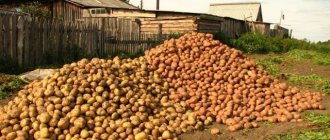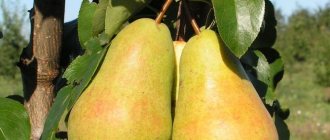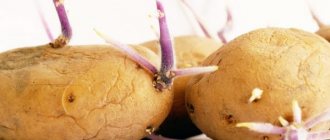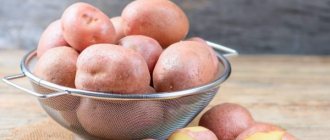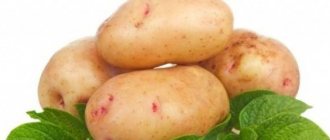Main characteristics
Gala is a medium-early ripening table variety. Bushes of medium height, semi-erect. The stems are of moderate thickness. The foliage is large, green, matte. There is a slight waviness along the edges. The culture produces small inflorescences and few flowers. The tops do not grow too much, but they close in rows at high speed.
Potatoes easily adapt to different soil compositions and climatic conditions. Gala can produce a harvest in almost any region of Russia. The variety, moreover, is not afraid of two types of nematodes, which increases its popularity among gardeners.
Description of fruits
Root vegetables have an attractive appearance. They have a smooth surface and a beautiful shade. The shape is oval, regular. The eyes are shallow. The size of the tubers is average, the weight ranges between 70 and 120 grams, although larger specimens are also found.
Thanks to their small eyes, potatoes are not difficult to peel. The pulp is dark yellow in color and may darken slightly when raw.
The potato flesh changes color depending on what the summer has been like.
Taste qualities, according to tasters, are very high. Professional rating – 9 out of 10 points.
The root vegetable is ideal for people who adhere to proper nutrition. It contains only 13% starch. At the same time, the composition includes carotene, 3% protein and vitamin C (11 mg per 100 g). In addition, potatoes contain potassium. The type of fruit boilability is A/B. After heat treatment, potatoes do not change their structure, do not turn black or fall apart.
The fruits show good keeping quality and can withstand transportation without problems. For this reason, the variety is often used for sale.
History of selection
Gala retains the bright yellow color of the pulp even after heat treatment
The Gala potato variety appeared as a result of the work of German agro breeders and became very popular in Russia. Two years ago it was one of the ten best varieties grown in the Russian Federation. For their early ripening and high resistance to temperature changes and parasites, Gala potatoes are loved by gardeners from regions located mainly in the central and northwestern Federal Districts - Vologda, Pskov, Kaliningrad, Leningrad, Yaroslavl.
Productivity
Gala shows good yield indicators. You can harvest potatoes for the first time 80 days after planting. One bush often produces about 25 tubers. If we take an industrial scale, we harvest up to 170 centners of root crops per hectare.
At the stage of technical ripeness at the end of the growing season, the yield is as follows: 220-263 c/ha.
The harvested crop can be stored in bags or boxes, or in bulk at a temperature of 2 to 6 degrees Celsius with a humidity of up to 80%.
Harvesting
Ripening time
Tubers of the Gala variety ripen 70–80 days after the appearance of the first shoots. The yield is on average from 20 to 25 root crops per bush weighing about 120 g. They have an oval shape and a smooth white skin. Potatoes are very resistant to mechanical damage.
The Gala variety has a regular round-oval shape
Storage duration
If you destroy the tops one and a half to two weeks before digging up the potatoes, you can achieve full ripening and increase the shelf life, which is already long for the Gala variety.
Important! Before collecting tubers in containers for winter storage, they must be thoroughly dried to avoid rotting.
Potatoes of the Gala variety have a long shelf life
Diseases and pests
Gala is not afraid of most diseases and pests that are relevant to potatoes, although sometimes precedents do occur. A separate advantage is the high resistance of the variety to the Colorado potato beetle. The most common diseases and pests are listed below.
Rhizoctoniosis
The disease manifests itself in the form of black or brown ulcers, which subsequently die off. Leaves begin to curl and stems die. Before planting, young individuals are treated with special preparations. If a problem occurs, they use products such as Baktofit, Maxim, and so on. For prevention, it is important to harvest the crop on time, process the crop and responsibly select planting material.
Late blight
Brown spots appear on the leaves. The reverse side is covered with a white coating. If you cut a tuber, you can see the so-called “rust”. To combat the disease, spray the tops with Bravo, Shirlan, Acrobat, Thanos. For the purpose of prevention, tubers are germinated and planting material is treated before planting.
Dry spotting
Dark brown spots appear, which quickly increase in size, merging together. For treatment, tubers are treated before planting using Agat-25, Baktofit, Bravo. Once every couple of weeks, when the disease manifests itself, spray with Profit. For prevention, the watering regime is carefully observed, especially if the weather is hot, and fed with nitrogen-containing fertilizers.
Brown bacterial rot
The leaves wrinkle and turn yellow en masse. To prevent pathology from occurring, treatment is carried out before planting using Planriz. For the purpose of prevention, potatoes are planted as far as possible from nightshades and try not to damage the tubers during harvesting.
Mosaic disease
Flowering disappears, the growing season decreases. There are no treatment methods yet, so any contaminated material is immediately removed and burned. Most likely, healthy bushes that were located next to diseased plants will have to be destroyed.
Click beetle larva
The crop is attacked by yellow-orange worms, they gnaw the tubers. Traps, spraying using Hurricane Forte, and “distractive” plantings are effective. For prevention, it is important to constantly dig the soil as deep as possible.
Potato moth
The caterpillars eat the plant and pollute it with their waste. To get rid of the pest, Karbofos is used.
Medvedka
Insects make tunnels in the ground, gnawing roots. To combat mole crickets, traps and watering with Karbofos are used.
How to harvest and store crops
Potatoes are harvested in the southern regions 2-3 times a year. In the central and northern regions, tubers are dug in August. First, you should dig up a few bushes to see the degree of ripening of the peel. Only after confidence in the full ripening of the crop do they begin to dig up the remaining potato bushes.
Additional Information . A couple of weeks before harvesting potatoes, the tops are cut off. This stimulates the ripening of root crops.
After digging up all the potatoes, the tubers are sorted. The seed material is selected and exposed to the sun for several days so that it turns green. Then it will be more resistant to disease and less attractive to rodents.
Warehouse potatoes must be firm, without rot, with soil residues. It is dried by leaving it indoors or outdoors in good weather.
Then placed in a cool, dark place with an air temperature of +3 °C. Humidity is maintained within 80%. For better preservation of the tubers, beets are also added there. It is advisable to provide moderate ventilation.
Wormwood shoots serve as prevention against rodents. Potatoes are stored in the cellar, basement or on the balcony. If a sharp cold snap is expected, the tubers can be covered with an old blanket or clothing.
The Gala variety has a high shelf life and retains its presentation for a long time. In good condition, up to 90% of the crop can withstand winter.
Potato storage
Advantages and disadvantages
Before planting any crop on your own plot, it is worth studying the advantages and disadvantages. Gala has the following pros and cons:
Advantages
- The harvest ripens under any conditions; planting dates are not important.
- Potatoes can be harvested very early.
- The crop stores well, withstands transportation, and retains its transport characteristics for a long time.
- Good yield indicators: up to 25 tubers per bush.
- Potatoes are ideal for people who adhere to the principles of a healthy diet due to their low starch content.
- The taste of root vegetables is very pleasant; they do not fall apart or darken during heat treatment.
- Gala is unpretentious in terms of care.
Flaws
- Susceptibility to rhizoctonia.
- Depends on soil moisture.
Diseases
The Gala variety is resistant to diseases, but is prone to fungal infections:
- Rhizoctoniosis (black scab). It is important to inspect the bushes regularly. Black tubercles are clearly visible on the tubers, resembling pieces of earth in appearance. The fungus affects the lower part of the shoots and they wither. You can eat such vegetables; they are absolutely safe. But using potatoes for planting is strictly contraindicated. The tops must be burned and the soil treated with antifungal agents. For preventive purposes, add ash to the hole when planting.
- Late blight. A dangerous disease that affects both the aerial part and the tuberous part. Harvest losses are enormous, sometimes up to 50%. Fungal infection spreads at an accelerated pace. To prevent plantings, they are treated with preparations against late blight. Affected potatoes are not used for planting, otherwise infection is inevitable. In regions with a rainy climate, it is worth selecting varieties that are resistant to the disease.
Reference! “Gala is practically not affected by cancer and potato nematode.
The permanent enemy of all vegetable crops is the mole cricket. In places where it appears, the soil is carefully dug up onto the bayonet of a shovel. The preparations are placed in the holes during planting and additionally applied during weeding or hilling.
Landing
There are no exact dates for planting the variety. The soil temperature at a depth of 10 centimeters should remain at +10 degrees for a long time.
It is very important to study the material before planting. It is best to buy it from trusted gardeners or nurseries.
It is not recommended to select small tubers from last year, as this causes degeneration of the variety. It is very important to start germination in advance so that seedlings appear a few days after planting. Experts advise sending the tubers into wooden boxes, 2-3 rows, sprinkling each of them with wet sawdust.
After this, you will need to choose the optimal location for placement. The variety feels best in loamy and well-moistened soils with moderate acidity. In the fall, ammonium nitrate, 30% potassium salt and double superphosphate are added to the digging.
Before planting, the soil is fertilized with the following mixture: 5 tbsp. l. wood ash, ½ tbsp. bone meal, 1 tbsp. l. urea, 1 tbsp. l. superphosphate, 1 tsp. potassium sulfate, 700 g of rotted manure. It is advisable to plant potatoes at a distance of 70 centimeters from each other, sprinkling 10 centimeters of soil on top.
Planting and growing Gala potatoes
The speed and quality of its germination, as well as the further development of the plant, depend on the correct planting of potatoes.
Preparing for landing
It is better to purchase seed material in specialized stores and at agricultural fairs. If they take tubers from their own plot, then they select bushes with a rich harvest.
First you need to select the right planting material. For this, medium-sized potatoes are used - 80-100 g. Small tubers can lead to degeneration. In addition, they may have few eyes for germination. Very large specimens are likely to rot.
For better germination, it is recommended to germinate the potatoes before planting.
The following methods are used:
- Dry germination. The tubers are placed in plastic bags with holes for ventilation. Keep them there for about a month at room temperature. During this time, the potatoes should turn green.
- Wet germination. The tubers are sprinkled with wet peat, humus or dry sawdust for 3-4 weeks. The room temperature should be 15 °C.
- Withering. Root crops are placed on the surface in one layer at a temperature of 16-18 °C for 10-20 days. The potatoes will turn green and begin to sprout.
Seed potatoes
If there are few seed potatoes, the tubers can be cut. For proper separation you need:
- Disinfect the knife after each tuber, since after contact with diseased potatoes, you can infect others.
- The root crop is cut lengthwise. With a cross cut, a good harvest is obtained from only one part of the tuber.
- Each half should have 2-3 buds.
Care
Caring for the Gala variety is not difficult. The most important thing is to provide it with enough moisture.
Be sure to periodically loosen the soil. Already 5 days after landing, this event is held. In the future, it is repeated as a crust appears on the ground. To protect against temperature changes, hilling is done.
Water three times a season, if there is a drought, then more often. Manipulations are carried out in the morning or evening using a watering can with a spray.
You shouldn’t overwater the plant, even though it loves moisture.
How to grow potatoes?
Beginners who want to plant a variety on their site should remember that despite all the unpretentiousness of this species to the soil, the main condition for yield will be a good location and nutritious soil. Preliminary work on the garden plantation should begin in the fall. It is necessary to deeply plow or dig up the soil with a shovel, the depth level is up to 30 cm. To make it easier, gardeners use various devices - for example, a drill, which helps make holes in the ground when planting seeds.
Immediately apply both organic and mineral fertilizers. You can add compost or humus at 5-7 kilograms, superphosphate up to 40 grams, potassium sulfate up to 15 grams per 1 sq. m. The selected place is dug up or loosened, and with the onset of warm days, ammonium nitrate is added to the soil up to 20 grams per square meter. Tubers are planted at the end of April until May 10-15.
A unique method for this specimen, used in the southern region of the country (Stavropol, Krasnodar Territories, Rostov Region), is planting in straw. The principle is quite simple: the seeds are placed on the ground, covered with dry material, and watered.
Moisture is retained in the straw and creates favorable conditions for germination, in which case gardeners receive a high yield.
You can also dig a trench 30 cm deep, lay down the filling material, seeds and sprinkle with earth. Growing potatoes in nets is often used, which is very convenient for harvesting and greatly facilitates labor.
Feeding
The variety has a positive attitude towards fertilizing, although it can easily function without it. Before fertilizing, loosening is carried out. Contribute:
- Chicken droppings diluted with water in a ratio of 1 to 10. Water the furrows between the bushes.
- Urea (a tablespoon per 10 liters of water). One bush needs 0.5 liters.
- Ammonium nitrate at the rate of 20 g per 10 liters of water.
You can also use dry fertilizers. Scatter ½ teaspoon of urea under each bush.
Reviews
Stepan, Kursk : The Gala variety seems to me the most promising. You can plant it almost at any time; it produces a harvest early, and it is always of high quality and tasty. I constantly produce healthy and beautiful potatoes, without damage. I like that it can be easily cleaned and remains just as attractive when cooked. The taste is beyond praise. Ideal for frying!
Nadezhda, Ivanovo : I was pleased with the quality of Gala. The tubers are all the same size, beautiful, smooth. I didn’t particularly care for the plant, since I didn’t have time at all. I even managed to forget about him. And it unexpectedly produced 20 tubers per bush! And this is with almost complete lack of care. Of course, I will recommend him.
Alena, Poltava : Neighbors gave us several potato tubers to plant. They said it was the Gala variety. We didn’t expect anything special from this plant, but it unexpectedly gave us 10 buckets of harvest. I must say that potatoes are stored well; they were in our basement for a long time. I boiled it and fried it - it turned out great. Now I will only plant it at my dacha.



